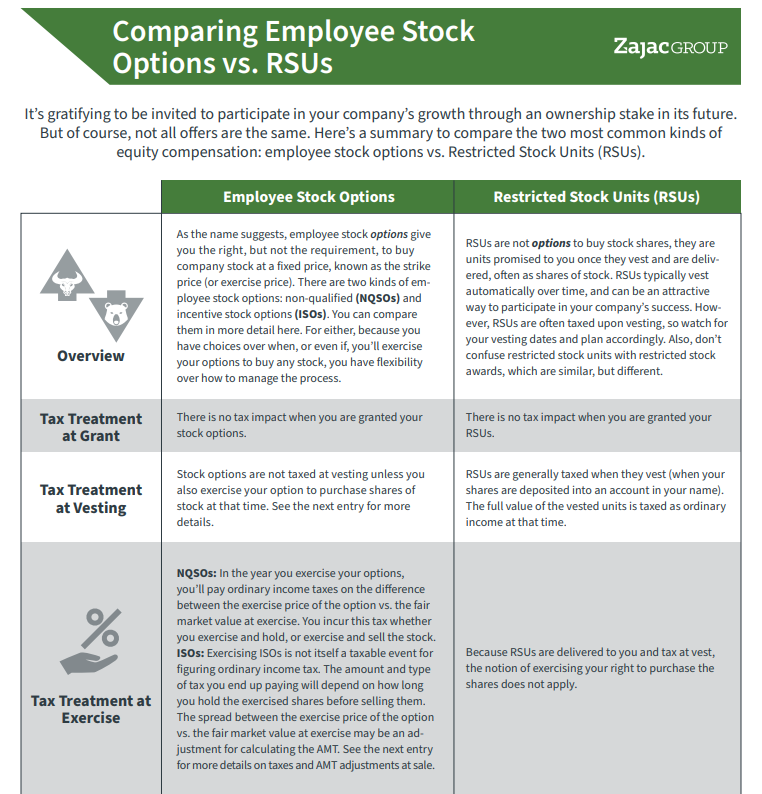
A common—and often correct—consensus is to sell the vested stock shares that originate from vested RSUs.Then again, for nearly every rule of thumb, there are exceptions. In particular: What if you hold RSUs AND other forms of company stock compensation? If you do, the usual advice may be too simplistic for your multifaceted needs. As we’ll demonstrate today, exercising and selling some of your incentive (or non-qualified) stock options instead of only vested RSU stock shares may offer more downside protection if your company’s stock price slumps. Whether you want or need that protection is up to you.
The Stand-Alone View of Your RSUs: Sell When They Vest
There are two reasons typically cited for promptly selling vested company stock shares that originate from vested RSUs:
The tax damage is already done: When restricted stock units vest, their value is taxable as ordinary income in the year they vest. Typically, your plan withholds some units to cover the estimated tax liability, and then deposits the balance into your account as company stock. If you sell these shares immediately (with no gain or loss since they vested), you’ll incur no additional tax impact from the sale. In our behaviorally biased brains, the money can end up feeling delightfully tax-free at the time.
Diversification is an investor’s best friend: More compellingly, selling company stock often makes sense to mitigate the risk of overconcentrating your wealth in a single holding. Plus, it’s your employer’s stock. If it stumbles, you may realize a double whammy of investment and career risks at the same time.
From this perspective, let’s explore RSU vesting as a stand-alone event. Upon vesting, your RSUs are no longer subject to significant forfeiture risk. But again, the full amount becomes taxable as ordinary income, and the RSUs are converted to stock shares. At that time, two things commonly occur:
COMPARISON GUIDE
Not All Stock Offers are the Same! Here's a helpful comparison between two of the most common employee stock options.
- Tax Withholdings: A portion of the units are withheld to cover the statutory tax withholdings on the full value of the vested RSUs. Typically, this includes a 22% withholding for Federal taxes, plus Social Security, Medicare, and state taxes.
- Stock Shares: After withholding, the remaining units are deposited as stock shares into your investment account.
From a tax perspective, vested RSUs look and feel very similar to a cash bonus. For both, the value is taxed as ordinary income. In fact, we would suggest that RSUs are the financial equivalent of a cash bonus, except the bonus is paid in stock instead of cash. This logic would suggest, if you would not use a cash bonus to buy company stock, you shouldn’t use your RSU bonus to hold company stock either. Subscribing to this thinking, your next step would be to sell the vested RSU shares immediately, turning the stock into cash, and giving yourself the cash bonus you would prefer.
But What If You Have Restricted Stock Units AND Employee Stock Options?
So, why might employees with multiple forms of equity compensation find it prudent to keep their vested RSU shares? Bottom line, if you have RSUs that vest, AND other equity compensation, it makes sense to look at your whole compensation package before deciding what to sell, in case the usual advice isn’t the best advice for you.
Again, in a silo, selling the proceeds of a vested RSU often makes a lot of sense. However, most of us don’t live in a silo. If you also have other forms of equity compensation, such as incentive stock options (ISOs) or non-qualified stock options (NQSOs), it’s important to think about your total stock compensation package—not only the tax ramifications, but also how to minimize the downside risk if you retain any stock or stock options, and the share price declines.
This makes your optimal action less obvious.
First, let’s assume you have restricted stock units and incentive stock options. From a tax-planning perspective, nothing changes when your RSUs vest. They are still taxable, and the net settled shares will still be available to you in your investment account. You’d still want to sell your vested RSU shares, convert the stock to cash, and retain the ISOs to avoid a second tax event.
But, again, taxes aren’t your only concern. You may also want to protect against excessive downside risk in your remaining shares or options, even if it might require a taxable tradeoff. Let’s take that more encompassing view next.
When Might Exercising and Selling Incentive Stock Options Make Sense?
We’ll now move past tax mitigation, and look at how to protect yourself against getting burned if your company stock declines and you’re still holding shares or options. By calculating projected terminal value, we’ll show you how KEEPING your vested RSU shares, and exercising and selling your vested ISOs instead can generate a more resilient experience, whether the stock price rises or falls.
Let’s explore a hypothetical illustration:
- Current Values of RSUs and ISOs:
- RSUs: 1,000 shares vesting at $30 per share = $30,000
- ISOs: 3,000 shares vested and unexercised with a fair market value (FMV) of $30 per share and a $20 strike = $30,000
Let’s also assume you want to liquidate and sell half your stock now, and retain half to sell later. Of course, you hope the price will go up, but what if it doesn’t? In this example, we’ll sell $30,000 worth of stock/options now and $30,000 later when, alas, the stock price has dropped to $20 per share.
Using this information, we will compare two scenarios.
- SCENARIO ONE: Sell 100% of the RSUs immediately as they vest, creating $30,000 in gross proceeds. Retain 100% of the ISOs to be sold later.
- SCENARIO TWO: Create the same $30,000 in gross proceeds through a combination of withheld RSUs, and an exercise/sale of ISOs.
IN SCENARIO ONE (selling the RSUs at vest and keeping the ISO unexercised), we see the following:
| Type | Current Value | Shares Sold at $30/share | Proceeds from Sale at $30/share | Shares Sold at $20/share | Proceeds from Sale at $20/share | Total Proceeds |
| RSU | $30,000 | 1,000 | $30,000 | 0 | $0 | $30,000 |
| ISO | $30,000 | 0 | $0.00 | 3,000 | $0 | $0 |
| Total | $60,000 | 1,000 | $30,000 | 3,000 | $0 | $30,000 |
Summary:
- The initial value of all stock/options is $60,000.
- The gross proceeds from the RSU sale are $30,000.
- The gross proceeds from an eventual secondary ISO sale are $0. The FMV of the stock will be $20 per share and the exercise price of the option will also be $20 per share.
- The total gross proceeds are $30,000 + $0 = $30,000
IN SCENARIO TWO (retaining the net-settled RSU shares, and exercising/selling enough incentive stock options to create $30,000 of gross proceeds) we see the following:
| Type | Current Value | Shares Sold at $30/share | Proceeds from Sale at $30/share | Shares Sold at $20/share | Proceeds from Sale at $20/share | Total Proceeds |
| RSU | $30,000 | 220 | $6,600 | 780 | $15,600 | $22,200 |
| ISO | $30,000 | 2,340 | $23,400 | 660 | $0 | $23,400 |
| Total | $60,000 | 4,560 | $30,000 | 1,440 | $15,600 | $45,600 |
Summary:
- The initial value of all stock/options is $60,000.
- The gross proceeds after the first sale are $30,000, which represents a combination of:
- 220 RSUs withheld at settlement at $30/share for $6,600
- An exercise and sale of 2,340 incentive stock options netting $23,400
The remaining retained RSU shares and unexercised NQSOs are then sold later, when the stock price is $20/share.
- The gross proceeds of the second sale are $15,600 from 780 RSU shares plus $0 from 660 unexercised incentive stock options.
- The total gross proceeds from all transactions are $30,000 + $15,600 = $45,600.
In short, Scenario Two generates 50% higher total gross proceeds than Scenario One.
When and Why Does This Look This Way?
First and foremost, retaining RSU shares post-vest and selling unexercised ISOs helps protect you in scenarios where the terminal value of the stock is lower than the FMV when the RSUs vest. This occurs thanks to leveraging on the stock options.
Before you decide how to split your vested RSU vs. ISO sales allocations, you or your financial advisor would want to analyze scenarios specific to your circumstances. In our illustration, the retained RSU shares declined by 33%. At this same time, the unexercised ISOs lost 100% of their value, as the FMV of the stock and the option strike price were equal.
To recap: If stock prices fall, Scenario One exposes you to a full dose of downside risk inherent to your retained ISOs. In Scenario Two, we’ve leveraged your multiple options to mitigate some of that risk by exercising and selling some of your ISOs and retaining some of the vested RSUs.
What If the Stock Goes Up?
By now, you may be wondering: What if the stock rises instead of falls? Here are the numbers to illustrate what would happen in each scenario if all other factors stayed the same, but the share price rose to $40 instead of dropping to $20.
IN SCENARIO ONE (selling the RSUs at vest and keeping the ISO unexercised), we see the following:
| Type | Current Value | Shares Sold at $30/share | Proceeds from Sale at $30/share | Shares Sold at $40/share | Proceeds from Sale at $40/share | Total Proceeds |
| RSU | $30,000 | 1,000 | $30,000 | 0 | $0 | $30,000 |
| ISO | $30,000 | 0 | $0.00 | 3,000 | $60,000 | $60,000 |
| Total | $60,000 | 1,000 | $30,000 | 3,000 | $60,000 | $90,000 |
IN SCENARIO TWO (retaining the net-settled RSU shares, and exercising/selling enough incentive stock options to create $30,000 of initial gross proceeds) we see the following:
| Type | Current Value | Shares Sold at $30/share | Proceeds from Sale at $30/share | Shares Sold at $40/share | Proceeds from Sale at $40/share | Total Proceeds |
| RSU | $30,000 | 220 | $6,600 | 780 | $31,200 | $37,800 |
| ISO | $30,000 | 2,340 | $23,400 | 660 | $13,200 | $36,600 |
| Total | $60,000 | 4,560 | $30,000 | 1,440 | $44,400 | $74,400 |
As you can see, there may be a price paid on the upside if you choose to protect against the downside risk. Is it worth it to you? That depends on you.
Is Keeping Your Vested Restricted Stock Shares a Good Idea?
Selling restricted stock units as they vest is a generally accepted financial planning norm, and likely a sensible move if you need only consider vested RSUs in isolation. For those who also hold other kinds of equity compensation, the choices are far more nuanced.
How much downside risk are you able to accept if you sell all your vested RSUs, retain all your ISOs or NQSOs, and hope your company stock soars? How devastating would it be to your financial wellbeing if the risk were realized? The answers are highly personal, and should inform the choices you make.
If you do want to minimize your downside risk, some variation on Scenario Two may be best for you. While this would incur a second taxable event and represent a more conservative approach, safeguarding what you’ve got may be well worth it to you and your eventual wealth. After all, it’s hard to retire on what might have been.
This material is intended for informational/educational purposes only and should not be construed as investment, tax, or legal advice, a solicitation, or a recommendation to buy or sell any security or investment product. The information contained herein is taken from sources believed to be reliable, however accuracy or completeness cannot be guaranteed. Please contact your financial, tax, and legal professionals for more information specific to your situation. Investments are subject to risk, including the loss of principal. Because investment return and principal value fluctuate, shares may be worth more or less than their original value. Some investments are not suitable for all investors, and there is no guarantee that any investing goal will be met. Past performance is no guarantee of future results. Talk to your financial advisor before making any investing decisions. The scenarios discussed are hypothetical examples and are for illustrative purposes only. No specific investments were used in these examples. Actual results will vary







0 Comments